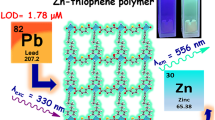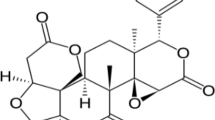Abstract
Hypochlorite is an important biological reactive oxygen species, which plays a pivotal role in various life activities. Excessive presence in the human body or excessive intake in life causes a series of diseases. To monitor the hypochlorite level in living cells, organisms and environment water samples, we herein designed and synthesized three organic small molecule fluorescent probes with different recognition sites based on nitrile biphenyl. Through performance comparison, it was found that probe A-HM exhibited the best detection performance for hypochlorite with a low detection limit of 2.47 × 10–6 M. The introduction of hypochlorite will induce probe fluorescence A-HM to turn on, and the fluorescence colour will change from colourless to green. The application of A-HM in biological systems has been demonstrated by the imaging monitoring of hypochlorite in MCF-7, L929 cells and zebrafish. Furthermore, A-HM was also used for the accurate determination of the hypochlorite level in real water samples with high sensitivity and good recoveries.












Similar content being viewed by others
Data Availability
The date that support the findings of this study are available from the corresponding author upon reasonable request.
References
Tang X, Zhu Z, Liu R, Tang Y (2019) A novel ratiometric and colorimetric fluorescent probe for hypochlorite based on cyanobiphenyl and its applications. Spectrochim Acta Part A Mol Biomol Spectrosc 219:576–581. https://doi.org/10.1016/j.saa.2019.04.042
Han J et al (2018) A water-soluble fluorescent probe for monitoring hypochlorite in water and in living cells. Sens Actuators B Chem 273:778–783. https://doi.org/10.1016/j.snb.2018.06.065
Khatib S, Musa R, Vaya J (2007) An exogenous marker: A novel approach for the characterization of oxidative stress. Bioorg Med Chem 15:3661–3666. https://doi.org/10.1016/j.bmc.2007.03.052
Han X, Ma Y, Chen Y, Wang X, Wang Z (2020) Enhancement of the aggregation-induced emission by hydrogen bond for visualizing hypochlorous acid in an inflammation model and a hepatocellular carcinoma model. Anal Chem 92:2830–2838. https://doi.org/10.1021/acs.analchem.9b05347
Li H et al (2020) A mitochondria-targeted fluorescent probe for fast detecting hypochlorite in living cells. Dyes Pigm 176:108192. https://doi.org/10.1016/j.dyepig.2020.108192
Balamurugan A, Lee H-I (2015) Aldoxime-derived water-soluble polymer for the multiple analyte sensing: consecutive and selective detection of Hg2+, Ag+, ClO–, and cysteine in aqueous media. Macromolecules 48:3934–3940. https://doi.org/10.1021/acs.macromol.5b00731
Zhu B et al (2018) A highly specific and ultrasensitive fluorescent probe for monitoring hypochlorous acid and its applications in live cells. Sens Actuators B Chem 267:589–596. https://doi.org/10.1016/j.snb.2018.04.011
Wu L et al (2017) Photostable ratiometric pdot probe for in vitro and in vivo imaging of hypochlorous acid. J Am Chem Soc 139:6911–6918. https://doi.org/10.1021/jacs.7b01545
Tang X, Zhu Z, Liu R, Tang Y (2019) A novel ratiometric and colorimetric fluorescent probe for hypochlorite based on cyanobiphenyl and its applications. Spectrochim Acta A Mol Biomol Spectrosc 219:576–581. https://doi.org/10.1016/j.saa.2019.04.042
Hazell LJ et al (1996) Presence of hypochlorite-modified proteins in human atherosclerotic lesions. J Clin Invest 97:1535–1544. https://doi.org/10.1172/jci118576
Zhang YR, Meng N, Miao JY, Zhao BX (2015) A ratiometric fluorescent probe based on a through-bond energy transfer (TBET) system for imaging HOCl in living cells. Chemistry 21:19058–19063. https://doi.org/10.1002/chem.201503500
Green PS et al (2004) Neuronal expression of myeloperoxidase is increased in Alzheimer’s disease. J Neurochem 90:724–733. https://doi.org/10.1111/j.1471-4159.2004.02527.x
Güngör N et al (2010) Genotoxic effects of neutrophils and hypochlorous acid. Mutagenesis 25:149–154. https://doi.org/10.1093/mutage/gep053
Prokopowicz ZM et al (2010) Hypochlorous acid: a natural adjuvant that facilitates antigen processing, cross-priming, and the induction of adaptive immunity. J Immunol 184:824–835. https://doi.org/10.4049/jimmunol.0902606
Manna A, Goswami S (2015) Ratiometric detection of hypochlorite applying the restriction to 2-way-ESIPT: Simple design for “naked-eye” tap water analysis. New J Chem 39. https://doi.org/10.1039/C5NJ00307E
Zhang F et al (2017) A unique iridium(III) complex-based chemosensor for multi-signal detection and multi-channel imaging of hypochlorous acid in liver injury. Biosens Bioelectron 87:1005–1011. https://doi.org/10.1016/j.bios.2016.09.067
Karmegam MV, Karuppannan S, Christopher Leslee DB, Subramanian S, Gandhi S (2020) Phenothiazine-rhodamine-based colorimetric and fluorogenic “turn-on” sensor for Zn(2+) and bioimaging studies in live cells. Luminescence 35:90–97. https://doi.org/10.1002/bio.3701
Qu W et al (2019) Construction of a novel far-red fluorescence light-up probe for visualizing intracellular peroxynitrite. Talanta 197:431–435. https://doi.org/10.1016/j.talanta.2019.01.065
Zhan Z, Liu R, Chai L, Dai Y, Lv Y (2019) Visualization of Lung Inflammation to Pulmonary Fibrosis via Peroxynitrite Fluctuation. Anal Chem 91:11461–11466. https://doi.org/10.1021/acs.analchem.9b02971
Wang Y et al (2019) Hg2+-selective ratiometric and colorimetric probe based on dansyl–rhodamine and its staining function in cell imaging. Luminescence 34:911–917
Xu X et al (2019) Mitochondrial-targeted near-infrared fluorescence probe for selective detection of fluoride ions in living cells. Talanta 204:655–662. https://doi.org/10.1016/j.talanta.2019.06.028
Yue Y, Huo F, Yin C, Escobedo JO, Strongin RM (2016) Recent progress in chromogenic and fluorogenic chemosensors for hypochlorous acid. Analyst 141:1859–1873. https://doi.org/10.1039/c6an00158k
Zhu H, Fan J, Wang J, Mu H, Peng X (2014) An, “enhanced PET”-based fluorescent probe with ultrasensitivity for imaging basal and elesclomol-induced HClO in cancer cells. J Am Chem Soc 136:12820–12823
Zhu B et al (2016) Highly specific and ultrasensitive two-photon fluorescence imaging of native HOCl in lysosomes and tissues based on thiocarbamate derivatives. Anal Chem 88:12532–12538
Chen X et al (2016) Synthesis of a highly HOCl-selective fluorescent probe and its use for imaging HOCl in cells and organisms. Nat Protoc 11:1219–1228. https://doi.org/10.1038/nprot.2016.062
Zhang R, Song B, Yuan J (2018) Bioanalytical methods for hypochlorous acid detection: Recent advances and challenges. TrAC, Trends Anal Chem 99:1–33. https://doi.org/10.1016/j.trac.2017.11.015
Liu Z et al (2018) A FRET chemosensor for hypochlorite with large Stokes shifts and long-lifetime emissions. Sens Actuators B Chem 262:958–965. https://doi.org/10.1016/j.snb.2018.01.240
Chen H et al (2020) Execution of aggregation-induced emission as nano-sensors for hypochlorite detection and application for bioimaging in living cells and zebrafish. Talanta 214:120842. https://doi.org/10.1016/j.talanta.2020.120842
Pan H et al (2019) A dual-function colorimetric probe based on Carbazole-Cyanine dyad for highly sensitive recognition of cyanide and hypochlorous acid in aqueous media. Talanta 202:329–335. https://doi.org/10.1016/j.talanta.2019.05.009
Wu WL et al (2019) A novel lipid droplets-targeting ratiometric fluorescence probe for hypochlorous acid in living cells. Talanta 194:308–313. https://doi.org/10.1016/j.talanta.2018.10.006
Li Q, Zhan Z, Zhang K, Song H, Lv Y (2020) Ratiometric two-photon fluorescent probe for detection of hypochlorite in living cells. Talanta 217:121099. https://doi.org/10.1016/j.talanta.2020.121099
Huang Y, Zhang Y, Huo F, Chao J, Yin C (2019) A near-infrared ratiometric fluorescent probe with large stokes based on isophorone for rapid detection of ClO− and its bioimaging in cell and mice. Sens Actuators B Chem 287:453–458. https://doi.org/10.1016/j.snb.2019.02.075
Xie X et al (2018) A two-photon fluorescent probe for ratiometric visualization of hypochlorous acid in live cells and animals based on a selenide oxidation/elimination tandem reaction. Chem Commun (Camb) 54:11965–11968. https://doi.org/10.1039/c8cc07312k
Xu Q et al (2015) Development of imidazoline-2-thiones based two-photon fluorescence probes for imaging hypochlorite generation in a co-culture system. Angew Chem Int Ed Engl 54:4890–4894. https://doi.org/10.1002/anie.201500537
Chang C et al (2017) Benzothiazole-based fluorescent sensor for hypochlorite detection and its application for biological imaging. Sens Actuators B Chem 243:22–28. https://doi.org/10.1016/j.snb.2016.11.123
Zhan Z et al (2017) Turn-on Fluorescent Probe for Exogenous and Endogenous Imaging of Hypochlorous Acid in Living Cells and Quantitative Application in Flow Cytometry. Anal Chem 89:9544–9551. https://doi.org/10.1021/acs.analchem.7b02613
Zhan Z, Zhang K, Zhang L, Li Q, Lv Y (2020) Development of iridium(III) phosphorescent probe for hypochlorous acid detection in macrophages cells and cancer cells co-culture system and application in inflamed mouse model. Sens Actuators B Chem 303:127016. https://doi.org/10.1016/j.snb.2019.127016
Yi S et al (2020) A novel mitochondria-targeted phosphorescence probe for hypochlorite ions detection in living cells. Talanta 209:120516. https://doi.org/10.1016/j.talanta.2019.120516
Li D et al (2016) A mitochondria-targeted two-photon fluorescent probe for highly selective and rapid detection of hypochlorite and its bio-imaging in living cells. Sens Actuators B Chem 222:483–491. https://doi.org/10.1016/j.snb.2015.08.098
Mao Z et al (2018) Design of a ratiometric two-photon probe for imaging of hypochlorous acid (HClO) in wounded tissues. Chem Sci 9:6035–6040. https://doi.org/10.1039/c8sc01697f
Chen X et al (2008) A highly selective and sensitive fluorescence probe for the hypochlorite anion. Chemistry 14:4719–4724. https://doi.org/10.1002/chem.200701677
Chen W-C, Venkatesan P, Wu S-P (2015) A highly selective turn-on fluorescent probe for hypochlorous acid based on hypochlorous acid-induced oxidative intramolecular cyclization of boron dipyrromethene-hydrazone. Anal Chim Acta 882:68–75. https://doi.org/10.1016/j.aca.2015.04.012
Li G et al (2017) A mitochondria-targeting fluorescence turn-on probe for hypochlorite and its applications for in vivo imaging. Sens Actuators B Chem 252:127–133. https://doi.org/10.1016/j.snb.2017.05.138
Pak YL et al (2018) Endoplasmic Reticulum-Targeted Ratiometric N-Heterocyclic Carbene Borane Probe for Two-Photon Microscopic Imaging of Hypochlorous Acid. Anal Chem 90:12937–12943. https://doi.org/10.1021/acs.analchem.8b03565
Cheng HR, Ji Y, Liu F, Lu XJ (2019) Rapid and visual detection for hypochlorite of an AIE enhanced fluorescence probe. Luminescence 34:903–910. https://doi.org/10.1002/bio.3689
Tang X et al (2018) A cyanobiphenyl based fluorescent probe for rapid and specific detection of hypochlorite and its bio-imaging applications. Sens Actuators B Chem 262:57–63. https://doi.org/10.1016/j.snb.2018.01.204
Tang X et al (2018) A relay identification fluorescence probe for Fe3+ and phosphate anion and its applications. Spectrochim Acta Part A Mol Biomol Spectrosc 191:172–179. https://doi.org/10.1016/j.saa.2017.10.018
Alici O, Erdemir S (2015) A cyanobiphenyl containing fluorescence “turn on” sensor for Al3+ ion in CH3CN–water. Sens Actuators B Chem 208:159–163. https://doi.org/10.1016/j.snb.2014.11.033
Das S et al (2018) Development of a new fluorescence ratiometric switch for endogenous hypochlorite detection in monocytes of diabetic subjects by dye release method. Tetrahedron Lett 59:1130–1135. https://doi.org/10.1016/j.tetlet.2018.02.023
Shinde RS (2021) Ultrasound Assisted Synthesis, Molecular Structure, UV-Visible Assignments, MEP and Mulliken Charges Study of (E)-3-(4-chlorophenyl)-1-(4-methoxyphenyl) prop-2-en-1-one: Experimental and DFT Correlational. Mater Sci Res India 18:86–96
Tang X et al (2020) Developed a novel quinazolinone based turn-on fluorescence probe for highly selective monitoring hypochlorite and its bioimaging applications. Spectrochim Acta A Mol Biomol Spectrosc 228:117845. https://doi.org/10.1016/j.saa.2019.117845
Wang L, Chen X, Xia Q, Liu R, Qu J (2018) Deep-Red AIE-Active Fluorophore for Hypochlorite Detection and Bioimaging in Live Cells. Ind Eng Chem Res 57:7735–7741. https://doi.org/10.1021/acs.iecr.8b01071
Li T et al (2018) Rational Design and Bioimaging Applications of Highly Specific “Turn-On” Fluorescent Probe for Hypochlorite. Bioconjug Chem 29:2838–2845. https://doi.org/10.1021/acs.bioconjchem.8b00430
Long L et al (2015) A fluorescent probe for hypochlorite based on the modulation of the unique rotation of the N-N single bond in acetohydrazide. Chem Commun (Camb) 51:10435–10438. https://doi.org/10.1039/c5cc03972j
Wang J, Ni Y, Shao S (2016) A reversible fluorescence probe for detection of ClO−/AA redox cycle in aqueous solution and in living cells. Talanta 147:468–472. https://doi.org/10.1016/j.talanta.2015.10.026
Acknowledgements
This work was supported by the Natural Science Foundation of Jiangsu Province (No. BK20190862), and China Postdoctoral Science Foundation funded project (No. 2019M651729). We are thankful for Dr. Xu Tang, of Institute for Advanced Materials, Jiangsu university.
Funding
The work was supported by the Natural Science Foundation of Jiangsu Province (No. BK20190862), and China Postdoctoral Science Foundation funded project (No. 2019M651729).
Author information
Authors and Affiliations
Contributions
The study conception and design were performed by Boxin Zhou and Xu Tang. Method development and validation were performed by Boxin Zhou and Xu Tang. The first draft of the manuscript was written by Boxin Zhou. All authors read and approved the final manuscript.
Corresponding author
Ethics declarations
Ethical Approval
This article does not contain any studies with human participants performed by any of the authors.
Conflict of Interest
The authors have no relevant financial or nonfinancial interests to disclose. The authors declare that there are no conflicts of interest.
Additional information
Publisher's Note
Springer Nature remains neutral with regard to jurisdictional claims in published maps and institutional affiliations.
Supplementary Information
Below is the link to the electronic supplementary material.
Rights and permissions
Springer Nature or its licensor (e.g. a society or other partner) holds exclusive rights to this article under a publishing agreement with the author(s) or other rightsholder(s); author self-archiving of the accepted manuscript version of this article is solely governed by the terms of such publishing agreement and applicable law.
About this article
Cite this article
Zhou, B., Han, Y., Liu, J. et al. Design and Synthesis of Novel Fluorescent Probe Based on Cyanobiphenyl and its Application in Detection of Hypochlorite. J Fluoresc 33, 575–586 (2023). https://doi.org/10.1007/s10895-022-03094-y
Received:
Accepted:
Published:
Issue Date:
DOI: https://doi.org/10.1007/s10895-022-03094-y




